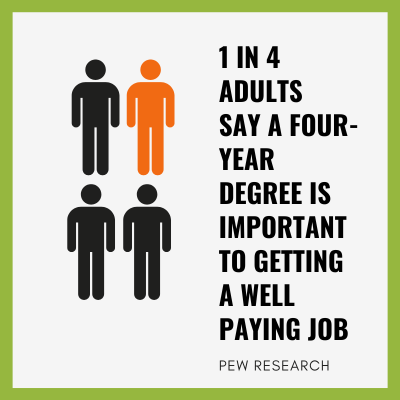Community colleges see the value of investing in tools to support students over age 22.
By Erika Gimbel
At Finger Lakes Community College in Canandaigua, New York, culinary instructor Patrick Rae is conducting a lecture on the science of a cooking technique.
He’s using an instructional method called HyFlex. Some students are in the classroom, and others, attending remotely, have their faces projected onto a screen on the back wall. Rae can interact with all the students to answer questions and hold discussions. Students who are unable to attend the class live can watch a recording at any time.
Like many community colleges across the country, many of Rae’s students are adult learners — also called “nontraditional” students — who are typically defined as being older than the usual full-time 18- to 22-year-old student and may be working full or part time. Data from the National Center for Educational Statistics shows that approximately 40 percent of students at two-year postsecondary institutions are 22 years old or older.
Teaching modalities like HyFlex can help retain older learners, whose numbers have dropped during the pandemic. According to Achieving the Dream, a nonprofit that champions evidence-based institutional improvement, between 2019 and 2021, community college enrollment fell 17.5 percent for students 25 to 29 years old, and 12.1 percent for students older than 29.
Technology can help. However, Ruanda Garth-McCullough, director of program development at ATD, advises colleges to be intentional about how they use and implement new learning tools. “For adult learners, time is precious. It’s important to design courses well and provide staff with time and resources for professional development,” she says. “It’s a lot more work, but it’s worth it when students don’t feel their time is being wasted.”
A HyFlex Teaching Model Makes Learning Accessible to Adult Students
Ryan McCabe, associate vice president of academic technology and high-impact practice at Finger Lakes Community College, describes the college’s population as “on the small side,” at approximately 5,500 full- and part-time students. About 40 percent are 22 years old or older. HyFlex courses have been beneficial.
“Adults seem the most interested in HyFlex,” says McCabe. “They have children, work, transportation issues. HyFlex offers them the opportunity to fully participate and not lose a step.”
FLCC had already started experimenting with HyFlex classes when the pandemic hit. The institution quickly added more, using primarily Cisco and Webex products and setting up the rooms with screens, motion-tracking cameras and microphones.
Continue reading here.
Or if you are ready to learn more about Jobspeaker, schedule a demo today.


